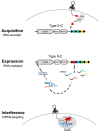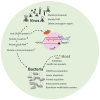Insights into the Human Virome Using CRISPR Spacers from Microbiomes
- PMID: 30205462
- PMCID: PMC6165519
- DOI: 10.3390/v10090479
Insights into the Human Virome Using CRISPR Spacers from Microbiomes
Abstract
Due to recent advances in next-generation sequencing over the past decade, our understanding of the human microbiome and its relationship to health and disease has increased dramatically. Yet, our insights into the human virome, and its interplay with important microbes that impact human health, is relatively limited. Prokaryotic and eukaryotic viruses are present throughout the human body, comprising a large and diverse population which influences several niches and impacts our health at various body sites. The presence of prokaryotic viruses like phages, has been documented at many different body sites, with the human gut being the richest ecological niche. Clustered Regularly Interspaced Short Palindromic Repeats (CRISPR) and associated proteins constitute the adaptive immune system of bacteria, which prevents attack by invasive nucleic acid. CRISPR-Cas systems function by uptake and integration of foreign genetic element sequences into the CRISPR array, which constitutes a genomic archive of iterative vaccination events. Consequently, CRISPR spacers can be investigated to reconstruct interplay between viruses and bacteria, and metagenomic sequencing data can be exploited to provide insights into host-phage interactions within a niche. Here, we show how the CRISPR spacer content of commensal and pathogenic bacteria can be used to determine the evidence of their phage exposure. This framework opens new opportunities for investigating host-virus dynamics in metagenomic data, and highlights the need to dedicate more efforts for virome sampling and sequencing.
Keywords: CRISPR spacers; CRISPR-Cas systems; microbiome; phages; virome.
Conflict of interest statement
R.B. is a co-inventor on several patents regarding CRISPR-Cas systems and their uses. R.B. is also a co-founder and SAB member of Intellia Therapeutics and Locus Biosciences. C.H.C. is a co-founder and SAB member of Microviable Therapeutics.
Figures



Similar articles
-
Holding a grudge: persisting anti-phage CRISPR immunity in multiple human gut microbiomes.RNA Biol. 2013 May;10(5):900-6. doi: 10.4161/rna.23929. Epub 2013 Feb 25. RNA Biol. 2013. PMID: 23439321 Free PMC article.
-
Metagenomic reconstructions of bacterial CRISPR loci constrain population histories.ISME J. 2016 Apr;10(4):858-70. doi: 10.1038/ismej.2015.162. Epub 2015 Sep 22. ISME J. 2016. PMID: 26394009 Free PMC article.
-
Dynamics of CRISPR-mediated virus-host interactions in the human gut microbiome.ISME J. 2024 Jan 8;18(1):wrae134. doi: 10.1093/ismejo/wrae134. ISME J. 2024. PMID: 39023219 Free PMC article.
-
Adaptation in CRISPR-Cas Systems.Mol Cell. 2016 Mar 17;61(6):797-808. doi: 10.1016/j.molcel.2016.01.030. Epub 2016 Mar 3. Mol Cell. 2016. PMID: 26949040 Review.
-
Clustered regularly interspaced short palindromic repeats (CRISPRs): the hallmark of an ingenious antiviral defense mechanism in prokaryotes.Biol Chem. 2011 Apr;392(4):277-89. doi: 10.1515/BC.2011.042. Epub 2011 Feb 7. Biol Chem. 2011. PMID: 21294681 Review.
Cited by
-
Identification and characterization of two CRISPR/Cas systems associated with the mosquito microbiome.Access Microbiol. 2023 Aug 11;5(8):acmi000599.v4. doi: 10.1099/acmi.0.000599.v4. eCollection 2023. Access Microbiol. 2023. PMID: 37691844 Free PMC article.
-
CRISPR-Cas systems are widespread accessory elements across bacterial and archaeal plasmids.Nucleic Acids Res. 2022 May 6;50(8):4315-4328. doi: 10.1093/nar/gkab859. Nucleic Acids Res. 2022. PMID: 34606604 Free PMC article.
-
CRISPRs for Strain Tracking and Their Application to Microbiota Transplantation Data Analysis.CRISPR J. 2019 Feb 1;2(1):41-50. doi: 10.1089/crispr.2018.0046. Epub 2019 Feb 14. CRISPR J. 2019. PMID: 30820491 Free PMC article.
-
Emergence of Invasive Serotype Ib Sequence Type 10 Group B Streptococcus Disease in Chinese Infants Is Driven by a Tetracycline-Sensitive Clone.Front Cell Infect Microbiol. 2021 May 14;11:642455. doi: 10.3389/fcimb.2021.642455. eCollection 2021. Front Cell Infect Microbiol. 2021. PMID: 34055663 Free PMC article.
-
Initial Mapping of the New York City Wastewater Virome.mSystems. 2020 Jun 16;5(3):e00876-19. doi: 10.1128/mSystems.00876-19. mSystems. 2020. PMID: 32546676 Free PMC article.
References
Publication types
MeSH terms
Grants and funding
LinkOut - more resources
Full Text Sources
Other Literature Sources
Miscellaneous

